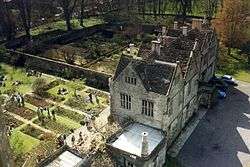Mells Manor
| Mells Manor | |
|---|---|
|
Mells Manor taken from the tower of the Church of St Andrew | |
| Location | Mells, Somerset, England |
| Coordinates | 51°14′31.47″N 2°23′31.79″W / 51.2420750°N 2.3921639°WCoordinates: 51°14′31.47″N 2°23′31.79″W / 51.2420750°N 2.3921639°W |
| Built | 16th century |
Listed Building – Grade I | |
| Designated | 11 March 1968[1] |
| Reference no. | 266729 |
 Location of Mells Manor in Somerset | |
Mells Manor at Mells, Somerset, England, was built in the 16th century for Edward Horner, altered in the 17th century, partially demolished around 1780, and restored by Sir Edwin Lutyens in the 20th century. The house, along with the garden walls, has been designated as a Grade I listed building,[1] and is closely associated with the adjacent Church of St Andrew.[2] The gardens are listed, Grade I, on the Register of Historic Parks and Gardens of special historic interest in England.[3]
The building was originally much more extensive than its current appearance, including a north wing, with two thirds of the building being demolished around 1780. It was then used as a farmhouse and subsequently as a school for boys undertaking holy orders.[4]
Mells manor was purportedly procured by Jack Horner upon discovering the deed in a pie given to him to carry to London by Richard Whiting, the last Abbot of Glastonbury. This act is supposedly referenced in the popular nursery rhyme Little Jack Horner. An alternative and more likely explanation is that the manor was bought from the King's Commissioners in 1543.[5][6]
The house was visited by Charles I and his troops in 1644.[4]
In 1724, Thomas Strangways Horner moved out of the manor house in the village and commissioned Nathaniel Ireson to build Park House within Mells Park.[7]
The park is bordered by the Mells River.[5] Many sites on the river and its tributaries, owned by the Horners were leased to James Fussell and his family to establish water-powered mills for the production of iron tools.[8]
The house is a residence of the Earl of Oxford and Asquith.
See also
References
- 1 2 "Mells Manor". Images of England. English Heritage. Retrieved 2009-05-28.
- ↑ Wickham, A.K. (1965). Churches of Somerset. Dawlish: David & Charles. p. 37.
- ↑ "Mells Manor House". National Heritage List for England. Historic England. Retrieved 9 February 2016.
- 1 2 Robinson, W.J. (1915). West Country Churches. Bristol: Bristol Times and Mirror Ltd. pp. 41–42.
- 1 2 "Park, Mells". Somerset Historic Environment Record. Somerset County Council. Retrieved 2009-09-25.
- ↑ Greenwood, Charles (1977). Famous houses of the West Country. Bath: Kingsmead Press. pp. 61–63. ISBN 978-0-901571-87-8.
- ↑ Firth, Hannah (2007). Mendip from the air. Taunton: Somerset County Council. ISBN 978-0-86183-390-0.
- ↑ Thornes, Robin (2010). Men of iron. The Fussells of Mells. Frome Society for Local Study. ISBN 978-0-9565869-1-9.
External links
- Mells Manor House, Frome, England at Parks & Gardens UK
